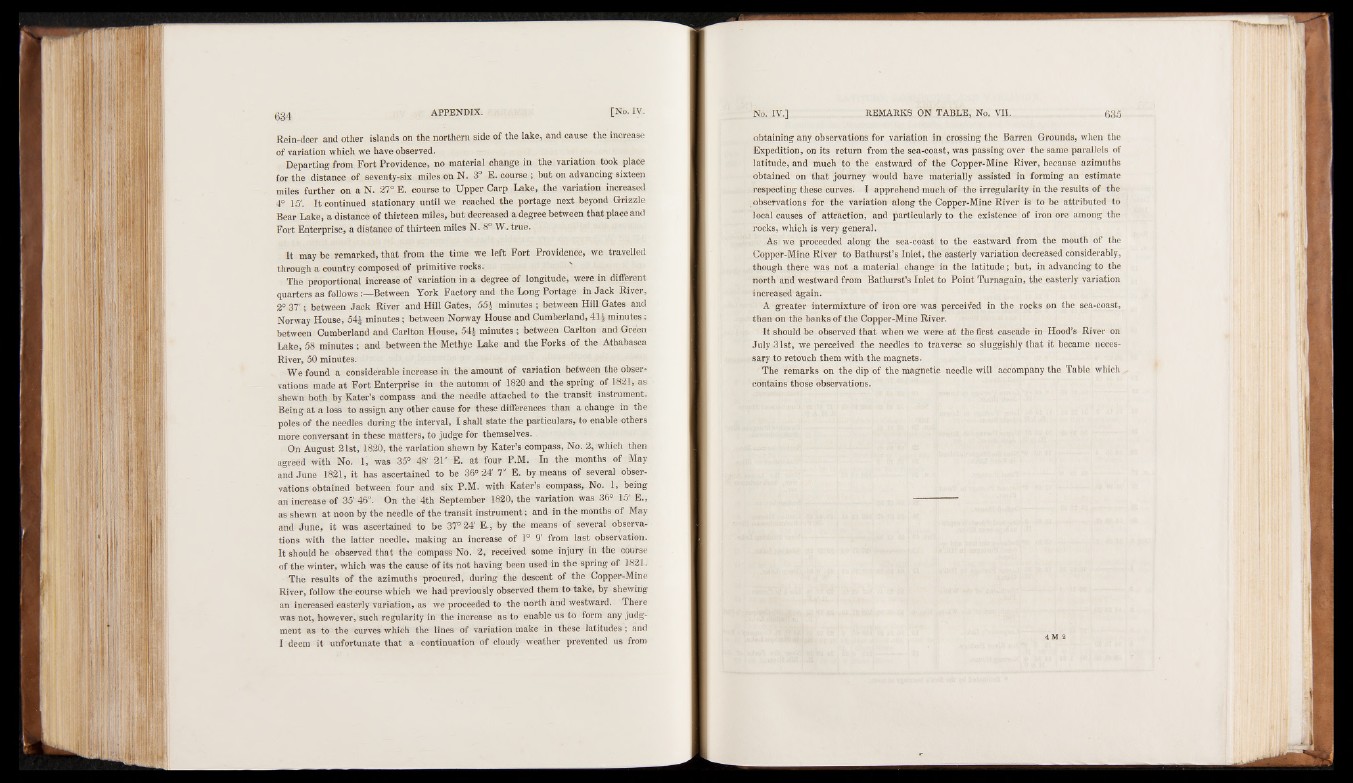
Rein-deer and other islands on the northern side of the lake, and cause the increase
of variation which we have observed.
Departing from Fort Providence, no material change in the variation took place
for the distance of seventy-six miles on N. 3° E. course ; but on advancing sixteen
miles further on a N. 27° E. course to Upper Carp Lake, the variation increased
4° 15'. It continued stationary until we reached the portage next beyond Grizzle
Bear Lake, a distance of thirteen miles, but decreased a degree between that place and
Fort Enterprise, a distance of thirteen miles N. 8° W. true.
It may be remarked, that from the time we left Fort Providence, we travelled
through a country composed of primitive rocks.
The proportional increase of variation in a degree of longitude, were in different
quarters as follows :—Between York Factory and the Long Portage in Jack River,
2° 37; between Jack River and Hill Gates, 55\ minutes ; between Hill Gates and
Norway House* 54£ minutes; between Norway House and Cumberland, 41 £ minutes;
between Cumberland and Carlton House, 54£ minutes ; between Carlton and Green
Lake, 58 minutes ; and between the Methye Lake and the Forks of the Athabasca
River, 50 minutes.
We found a considerable increase in the amount of variation between the observations
made at Fort Enterprise in the autumn of 1820 and the spring of 1821* as
shewn both by Rater’s compass and the needle attached to the transit instrument.
Being at a loss to assign any other cause for these differences than a change in the
poles of the needles during the interval, I shall state the particulars, to enable others
more conversant in these matters, to judge for themselves.
On August 21st, 1820, thé variation shewn by Rater’s compass, No. 2, which then
agreed with No. 1, was 35° 48' 21" E. at four P.M. In the months of May
and June 1821, it has ascertained to be 36° 24' 7" E. by means of several observations
obtained between four and six P.M. with Rater’s compass, No. 1, being
an increase of 35' 46". On the 4th September 1820, the variation was 36° 15' E.,
as shewn at noon by the needle of the transit instrument; and in the months of May
and June, it was ascertained to be 37° 24' E., by the means of several observations
with the latter needle, making an increase of 1° 9' from last observation.
It should be observed that the compass No. 2, received some injury in the course
of the winter, which was the cause of its not having been used in the spring of 1821.
The results of the azimuths procured, during the descent of the Copper-Mine
River, follow the course which we had previously observed them to take, by shewing
an increased easterly variation, as we proceeded to the north and westward. There
was not, however, such regularity in the increase as to enable us to form any judgment
as to the curves which the lines of variation make in these latitudes; and
I deem it unfortunate that a continuation of cloudy weather prevented us from
obtaining any observations for variation in crossing the Barren Grounds, when the
Expedition, on its return from the sea-coast, was passing over the same parallels of
latitude, and much to the eastward of the Copper-Mine River, because azimuths
obtained on that journey would have materially assisted in forming an estimate
respecting these curves. I apprehend much of the irregularity in the results of the
observations for the variation along the Copper-Mine River is to be attributed to
local causes of attraction, and particularly to the existence of iron ore among the
rocks, which is very general.
As we proceeded along the sea-coast to the eastward from the mouth of the
Copper-Mine River to Bathurst’s Inlet, the easterly variation decreased considerably,
though there was not a material change in the latitude; but, in advancing to the
north arid westward from Bathurst’s Inlet to Point Turnagain, the easterly variation
increased again.
A greater intermixture of iron ore was perceived in the rocks on the sea-coast,
than on the banks of the Copper-Mine River.
It should be observed that when we were at the first cascade in Hood’s River on
July 31st, we perceived the needles to traverse so sluggishly that it became necessary
to retouch them with the magnets.
The remarks on the dip of the magnetic needle will accompany the Table which
contains those observations.
4 M 2